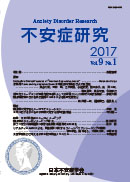Volume 9, Issue 1
Displaying 1-11 of 11 articles from this issue
- |<
- <
- 1
- >
- >|
Foreword
-
2017 Volume 9 Issue 1 Pages 1
Published: October 31, 2017
Released on J-STAGE: November 14, 2017
Download PDF (149K)
Original Articles
-
2017 Volume 9 Issue 1 Pages 2-16
Published: October 31, 2017
Released on J-STAGE: November 14, 2017
Download PDF (309K) -
2017 Volume 9 Issue 1 Pages 17-32
Published: October 31, 2017
Released on J-STAGE: November 14, 2017
Download PDF (399K) -
2017 Volume 9 Issue 1 Pages 33-41
Published: October 31, 2017
Released on J-STAGE: November 14, 2017
Download PDF (449K) -
2017 Volume 9 Issue 1 Pages 42-49
Published: October 31, 2017
Released on J-STAGE: November 14, 2017
Download PDF (438K)
Reviews
-
2017 Volume 9 Issue 1 Pages 50-56
Published: October 31, 2017
Released on J-STAGE: November 14, 2017
Download PDF (391K) -
2017 Volume 9 Issue 1 Pages 57-64
Published: October 31, 2017
Released on J-STAGE: November 14, 2017
Download PDF (365K)
Special Edition: Neuroimaging of Anxiety and Emotion
-
2017 Volume 9 Issue 1 Pages 65-68
Published: October 31, 2017
Released on J-STAGE: November 14, 2017
Download PDF (307K) -
2017 Volume 9 Issue 1 Pages 69-71
Published: October 31, 2017
Released on J-STAGE: November 14, 2017
Download PDF (331K) -
2017 Volume 9 Issue 1 Pages 72-75
Published: October 31, 2017
Released on J-STAGE: November 14, 2017
Download PDF (270K) -
2017 Volume 9 Issue 1 Pages 76-79
Published: October 31, 2017
Released on J-STAGE: November 14, 2017
Download PDF (288K)
- |<
- <
- 1
- >
- >|
